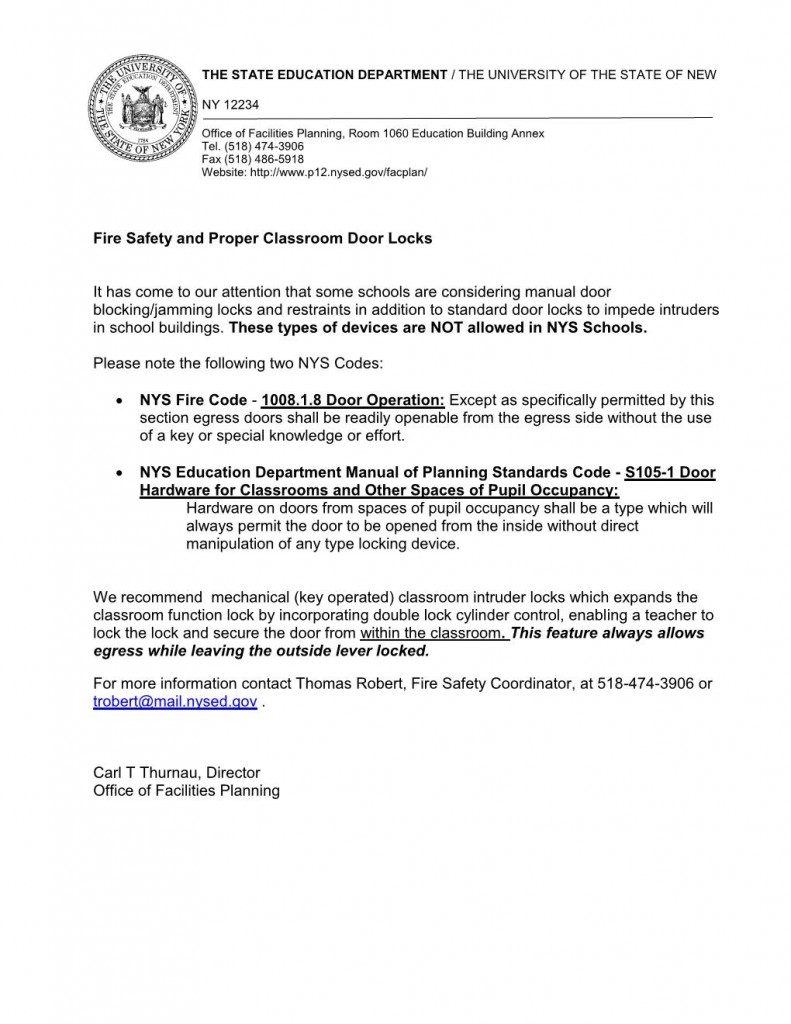It seems like just about every week I see a new classroom security device that promises to thwart intruders and help keeps kids safe in school. As I’ve said multiple times, many of these devices are not code-compliant, and trade security for life safety. In evaluating these products, my criteria are:
- It must not violate code requirements for free egress.
- It must not inhibit latching if the door is a fire door.
- It must not allow unauthorized locking which could encourage mischief and/or criminal behavior.
- It must be readily available and easy to install if needed.
In some cases, the facilities using these products may not be aware of the code requirements or they may think that security trumps codes in an intruder situation. They may have even convinced their local code official that these devices should be allowed in an emergency situation. I have not yet found any code officials who were willing to agree to this in writing, but I did find a memo (thanks to Andy Lindenberg of Allegion) from the New York State Education Department, which clearly states their position:
If you have access to similar documentation from another state or jurisdiction, please send it to me!
You need to login or register to bookmark/favorite this content.







Bravo NYSED!
Common sense prevails!
About ten years ago, I noticed that the emergency exit at a major subway stop here in Boston was chained closed. This exit was a door in a metal grill-type enclosure, with delayed egress panic hardware (if I recall correctly). I went to the station attendant to complain about this blatant safety issue. The reply was that it would help “prevent terrorists from planting a bomb” on the platform. Never mind that a fire is probably thousands of times more likely to occur, or that a terrorist could simply buy a fare and walk in like everyone else, or even that if a bomb did go off no one in the panicked crowd could get out of that exit! I complained more vociferously after hearing that explanation. Fortunately, within a couple days the chain was gone. Same thing in a school – a fire, even a small but smokey one, is so much more likely than a crazy with a gun. Sometimes people cannot make reasonable risk assessments.
no real documentation, but I contacted 2 local fire departments and the business administrator for my local municipality and they all said that door barricading devices for classrooms are ILLEGAL and are NOT used in the local school district.
what a coincidence of the date that you posted this article, one of the companies that make classroom security device that involves the door closer’s arms, one of the sales team members OFFERED to send me a complimentary closer arm BDSM device because of my involvement with them (asked some questions on their twitter page and once on their facebook)
I kindly declined the offer,
what would be a little better for acceptance of these devices if they would realize that handicapped/young children are not tall enough to reach the closer, and if you can’t reach the closer, how on earth are you suppose to remove or apply the device???
another point of view I am hoping the BDSM device maker finds out, not all closer arms are made the same, many cannot handle the pressure that the BDSM device applies to it, with it’s use, if the closer arm does not bend at the PA shoe bracket, you end up ruining the frame or damaging the closer mechanism itself at the pinion shaft (premature wear)
use of the device (door closer arm restraint/BDSM device) WILL VOID WARRANTY of the closer.
the other devices I have seen for classroom door security, I give them some credit for being low to the floor (in case a child/disabled person had to use it) but still, the bad side is the 2 motion egress, a big no-no in fire door codes world.
-Jess the door closer doctor